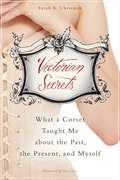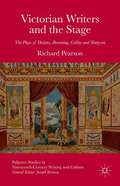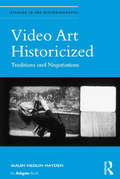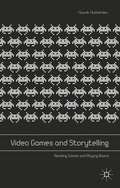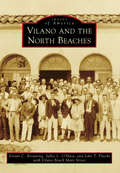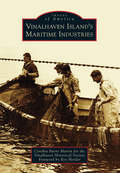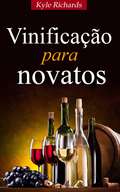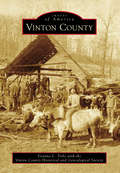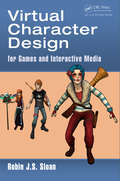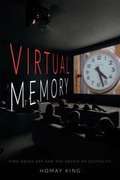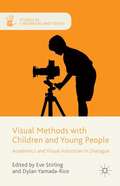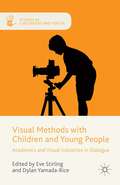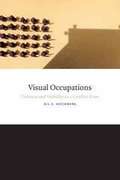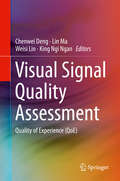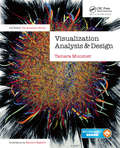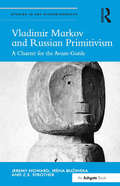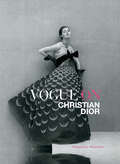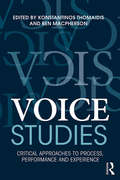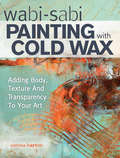- Table View
- List View
Victorian Secrets: What a Corset Taught Me about the Past, the Present, and Myself
by Sarah A. Chrisman Sue LeanOn Sarah A. Chrisman’s twenty-ninth birthday, her husband, Gabriel, presented her with a corset. The material and the design were breathtakingly beautiful, but her mind immediately filled with unwelcome views. Although she had been in love with the Victorian era all her life, she had specifically asked her husband not to buy her a corset?ever. She’d heard how corsets affected the female body and what they represented, and she wanted none of it. However, Chrisman agreed to try on the garment . . . and found it surprisingly enjoyable. The corset, she realized, was a tool of empowerment?not oppression. After a year of wearing a corset on a daily basis, her waist had gone from thirty-two inches to twenty-two inches, she was experiencing fewer migraines, and her posture improved. She had successfully transformed her body, her dress, and her lifestyle into that of a Victorian woman?and everyone was asking about it. In Victorian Secrets, Chrisman explains how a garment from the past led to a change in not only the way she viewed herself, but also the ways she understood the major differences between the cultures of twenty-first-century and nineteenth-century America. The desire to delve further into the Victorian lifestyle provided Chrisman with new insight into issues of body image and how women, past and present, have seen and continue to see themselves.
Victorian Writers and the Stage
by Richard PearsonThis book comprises a study of the plays of Dickens, Browning, Wilkie Collins and Tennyson, alongside the fiction and periodical writings of Thackeray and others. These major Victorian writers authored several professional plays, but why has their achievement been overlooked? Victorian Writers and the Stage brings together comprehensively, for the first time, the professionally performed plays of a group of well-known authors – some of which plays enjoyed long and successful seasons,but all of which have been largely forgotten. The author examines the goal of these writers to become part of an expanding theatrical industry and the problems they encountered in risking their reputations on a literature felt by many to be vulgar and illegitimate. A wealth of new detail carefully positions the plays within the context of the changing Victorian theatre industry and the great battle between the Major and Minor theatres for the future of the modern stage.
Video Art Historicized: Traditions and Negotiations (Studies in Art Historiography)
by Malin Hedlin HaydenVideo art emerged as an art form that from the 1960s and onwards challenged the concept of art - hence, art historical practices. From the perspective of artists, critics, and scholars engaged with this new medium, art was seen as too limiting a notion. Important issues were to re-think art as a means for critical investigations and a demand for visual reconsiderations. Likewise, art history was argued to be in crisis and in need of adapting its theories and methods in order to produce interpretations and thereby establish historical sense for moving images as fine art. Yet, as this book argues, video art history has evolved into a discourse clinging to traditional concepts, ideologies, and narrative structures - manifested in an increasing body of texts. Video Art Historicized provides a novel, insightful and also challenging re-interpretation of this field by examining the discourse and its own premises. It takes a firm conceptual approach to the material, examining the conceptual, theoretical, and methodological implications that are simultaneously contested by both artists and authors, yet intertwined in both the legitimizing and the historicizing processes of video as art. By engaging art history’s most debated concepts (canon, art, and history) this study provides an in-depth investigation of the mechanisms of the historiography of video art. Scrutinizing various narratives on video art, the book emphasizes the profound and widespread hesitations towards, but also the efforts to negotiate, traditional concepts and practices. By focusing on the politics of this discourse, theoretical issues of gender, nationality, and particular themes in video art, Malin Hedlin Hayden contests the presumptions that inform video art and its history.
Video Games and Storytelling
by Souvik MukherjeeGrand Theft Auto IV saw more copies being sold than the latest superhero blockbusters or the last Harry Potter novel. Most of its players and critics commend its storytelling experience; however, when it comes to academic analysis, mainstream humanities research seems confused about what to do with such a phenomena. The problem is one of classification, in the first instance: 'is it a story, is it a game, or is it a machine?' Consequently, it also becomes a problem of methodology – which traditional discipline, if any, should lay claim to video game studies becoming the moot question. After weathering many controversies with regards to their cultural status, video games are now widely accepted as a new textual form that requires its own media-specific analysis. Despite the rapid rise in research and academic recognition, video game studies has seldom attempted to connect with older media and to locate itself within broader substantive discourses of the earlier and more established disciplines, especially those in the humanities. Video Games and Storytelling aims to readdress this gap and to bring video games to mainstream humanities research and teaching. In the process, it is also a rethinking story versus game debate as well as other key issues in game studies such as time, agency, involvement and textuality in video game-narratives.
Vietnamese in Orange County
by Linda Trinh Vo Thuy Vo Dang Tram LeVietnamese Americans have transformed the social, cultural, economic, and political life of Orange County, California. Previously, there were Vietnamese international students, international or war brides, or military personnel living in the United States, but the majority arrived as refugees and immigrants after the end of the Vietnam War in 1975. Although they are lumped together as "refugees," Vietnamese Americans are diverse in terms of their class, ethnic, regional, religious, linguistic, and ideological backgrounds. Their migration path varied, and they often struggled with resettling in a new homeland and rebuilding their lives. They are dispersed throughout the country, but many are concentrated in central Orange County, where three cities--Westminster, Garden Grove, and Santa Ana--have "Welcome to Little Saigon" signs. They constitute the largest population of Vietnamese outside of Vietnam and have created flourishing residential neighborhoods and bustling commercial centers and contribute to the political and cultural life of the region. This book captures snapshots of Vietnamese life in Orange County over the span of 40 years and shows a dynamic, vibrant community that is revitalizing the region.
Viewing Inscriptions in the Late Antique and Medieval World
by Antony EastmondInscriptions convey meaning not just by their contents but also by other means, such as choice of script, location, scale, spatial organisation, letterform, legibility and clarity. The essays in this book consider these visual qualities of inscriptions, ranging across the Mediterranean and the Near East from Spain to Iran and beyond, including Norman Sicily, Islamic North Africa, Byzantium, medieval Italy, Georgia and Armenia. While most essays focus on Late Antiquity and the Middle Ages, they also look back at Achaemenid Iran and forward to Mughal India. Topics discussed include real and pseudo-writing, multilingual inscriptions, graffiti, writing disguised as images and images disguised as words. From public texts set up on mountainsides or on church and madrasa walls to intimate craftsmen's signatures, barely visible on the undersides of precious objects, the inscriptions discussed in this volume reveal their meanings as textual and visual devices.
Vilano and the North Beaches
by John T. Pilecki Sallie L. O’hara Vilano Beach Main Street Vivian C. BrowningVilano and the North Beaches are perhaps most known as small, eclectic beach communities within sight of St. Augustine, the nation's oldest city. For centuries, people have flocked to this coastal playground by horse-drawn trolley, ferry, and more recently Florida's Coastal Highway, State Road A1A. They came for recreation, jobs, and sunny weather in the late 1800s, when Henry Flagler attracted Northerners to his "new and novel" hotels. Visitors were excited to learn the ocean was just across the bay. Tourism provided jobs for settlers, like the Minorcan, Usina, and Capo families, offering fun excursions. Nowhere else were horse-drawn trolleys delivering beachgoers across sand dunes to the sea. Like Ponce de León, who was smitten with the pristine beaches, the area's story is one of developing the land along an isolated coastline. Road and bridge construction after World War II encouraged migration as well as visitors to the beaches, fish camps, and Art Deco motor courts. This nostalgic 1950s look remains today, attracting those curious about the region's multicultural history.
Vinalhaven Island's Maritime Industries (Images of America)
by Roy Heisler Vinalhaven Historical Society Cynthia Burns MartinVinalhaven Island has been the home port of a productive commercial fishing fleet for over 200 years. By 1819, Vinalhaven vessels were fishing for cod and herring from Seal Island all the way to Labrador waters. By 1878, Carver's Harbor was lined with docks, fishhouses, a sail loft, a net factory, and the Lane & Libby fish plant. Throughout the 19th century, boats brought bait, salt, and supplies to Vinalhaven and returned with fish and granite from the island's quarries. Lighthouses at Brown's Head, Heron Neck, Saddleback Ledge, Goose Rock, and Matinicus guided mariners through storms. In Vinalhaven shops, boatbuilders constructed small dories, peapods and double-enders, masted schooners, and lobster boats, as well as the 365-ton Margaret M. Ford. Passenger ferries played an important role as the primary link between Vinalhaven and the mainland. The island has long been a successful center of maritime economic activity, so it is no surprise that islanders call it "the center of the universe."
Vincent Paints His House
by Tedd ArnoldVincent is ready to paint his house—but what color should it be? He starts painting it white, but the spider says it's his house, and he likes red. The caterpillar says it's his house and he likes yellow. The beetle likes purple, and the bird likes blue. Each color introduces a new variety of vibrant shades, filling Vincent&’s palette with too many options. But, creative genius that he is, Vincent finds a way to make everyone happy! Blending his signature cartoonish style with the textures and color choices of a certain post-impressionist Vincent, Tedd Arnold has created a simple story about friendship and compromise which is also a quiet, charming introduction to one of the most famous painters of history.
Vinificação para novatos
by Kyle Richards Elen CantoSe você é um especialista ou apenas gosta de provar um vinho de vez em quando, Vinificação para novatos é o guia perfeito para proporcionar-lhe o orgulho e o prazer de fabricar seu próprio vinho! Não se intimide pelos hectares de uvas e galpões com maquinários que encontramos nas vinícolas. Você pode fazer vinho em casa, e este e-book lhe mostra como! Não precisa ter experiência, pois dividimos o processo em passos simples para que qualquer um consiga fazer um vinho delicioso e cheiroso em casa enquanto se diverte! Compartilhe com sua família e amigos ou guarde para uma ocasião especial. É um muito gratificante dar de presente uma garrafa de vinho que você fez para um amigo ou ente querido. Quem nunca fez vinho costuma ter as seguintes dúvidas: · Que tipo de uva devo usar? · Qual é o equipamento necessário? · Quanto ele custa? · É difícil fazer vinho em casa? · Como ele é feito? Este e-book responde a essas e outras perguntas. Com nosso simples processo, seu vinho preferido logo terá seu nome no rótulo! Chega de pesquisar vinhos misteriosos e caros nas intermináveis prateleiras das adegas. Vinificação para novatos vai permitir que você comece a fazer seu vinho imediatamente. Baixe já seu exemplar!
Vinton County
by Deanna L. Tribe Vinton County Historical and Genealogical SocietyWhen Ohio became a state in 1803, settlement of what would become Vinton County had hardly begun. Largely forested then and now, Vinton was carved out of the five adjacent counties and in 1850 became the second-to-last county established in Ohio. McArthur, which later became the county seat with a population of 424, was laid out as the village of McArthurstown in 1815; the village celebrates its bicentennial in 2015, having grown to about 1,700 residents. Although rural in manner, life, and outlook, Vinton Countians have maintained a strong sense of community through both good and bad times in this part of Ohio Appalachia. Images of America: Vinton County features images from the Vinton County Historical and Genealogical Society and photograph collections shared by residents. This book presents a snapshot of the county's history, heritage, and culture--a story seldom presented in print.
Virtual Character Design for Games and Interactive Media
by Robin James SloanWhile the earliest character representations in video games were rudimentary in terms of their presentation and performance, the virtual characters that appear in games today can be extremely complex and lifelike. These are characters that have the potential to make a powerful and emotional connection with gamers. As virtual characters become more
Virtual Memory: Time-Based Art and the Dream of Digitality
by Homay KingIn Virtual Memory, Homay King traces the concept of the virtual through the philosophical works of Henri Bergson, Gilles Deleuze, and Giorgio Agamben to offer a new framework for thinking about film, video, and time-based contemporary art. Detaching the virtual from its contemporary associations with digitality, technology, simulation, and speed, King shows that using its original meaning--which denotes a potential on the cusp of becoming--provides the means to reveal the "analog" elements in contemporary digital art. Through a queer reading of the life and work of mathematician Alan Turing, and analyses of artists who use digital technologies such as Christian Marclay, Agnès Varda, and Victor Burgin, King destabilizes the analog/digital binary. By treating the virtual as the expression of powers of potential and change and of historical contingency, King explains how these artists transcend distinctions between disembodiment and materiality, abstraction and tangibility, and the unworldly and the earth-bound. In so doing, she shows how their art speaks to durational and limit-bound experience more than contemporary understandings of the virtual and digital would suggest.
Visio Services Quick Guide
by Sahil Malik Srini SistlaIn this fast-paced 100-page guide, you'll learn to load, display and interact with dynamic, data-powered Visio diagrams in SharePoint 2013 or Office 365. Visio Services Quick Guide gives you the tools to build anything from a simple project workflow to an organizational infrastructure diagram, powered by real data from SharePoint or SQL Server. Colleagues can load your diagrams entirely in the browser, meaning that a single Visio client installation is enough to get started. Readers with JavaScript experience will also find out how to get additional control over Visio diagrams using the JavaScript mashup API, and how to build a custom data provider. The final chapter covers some useful information on administering Visio Services. Get started bringing your Visio diagrams to life with the Visio Services Quick Guide.
Visual Culture in Contemporary China
by Xiaobing TangExploring a wealth of images ranging from woodblock prints to oil paintings, this beautifully illustrated full-color study takes up key elements of the visual culture produced in the People's Republic of China from its founding in 1949 to the present day. In a challenge to prevailing perceptions, Xiaobing Tang argues that contemporary Chinese visual culture is too complex to be understood in terms of a simple binary of government propaganda and dissident art, and that new ways must be sought to explain as well as appreciate its multiple sources and enduring visions. Drawing on rich artistic, literary, and sociopolitical backgrounds, Tang presents a series of insightful readings of paradigmatic works in contemporary Chinese visual arts and cinema. Lucidly written and organized to address provocative questions, this compelling study underscores the global and historical context of Chinese visual culture and offers a timely new perspective on our understanding of China today.
Visual Methods with Children and Young People: Academics and Visual Industries in Dialogue (Studies in Childhood and Youth)
by Eve Stirling Dylan Yamada-RiceVisual Methods with Children and Young People.
Visual Methods with Children and Young People: Academics and Visual Industries in Dialogue (Studies in Childhood and Youth)
by Eve Stirling Dylan Yamada-RiceThis volume focuses on using visual research methods with children and young people. Featuring insights from academic experts and established professionals from visual industries, it explores a range of issues from visual ethics to children's interaction with place.
Visual Occupations: Violence and Visibility in a Conflict Zone
by Gil Z. HochbergIn Visual Occupations Gil Z. Hochberg shows how the Israeli Occupation of Palestine is driven by the unequal access to visual rights, or the right to control what can be seen, how, and from which position. Israel maintains this unequal balance by erasing the history and denying the existence of Palestinians, and by carefully concealing its own militarization. Israeli surveillance of Palestinians, combined with the militarized gaze of Israeli soldiers at places like roadside checkpoints, also serve as tools of dominance. Hochberg analyzes various works by Palestinian and Israeli artists, among them Elia Suleiman, Rula Halawani, Sharif Waked, Ari Folman, and Larry Abramson, whose films, art, and photography challenge the inequity of visual rights by altering, queering, and manipulating dominant modes of representing the conflict. These artists' creation of new ways of seeing--such as the refusal of Palestinian filmmakers and photographers to show Palestinian suffering or the Israeli artists' exposure of state manipulated Israeli blindness --offers a crucial gateway, Hochberg suggests, for overcoming and undoing Israel's militarized dominance and political oppression of Palestinians.
Visual Signal Quality Assessment
by Lin Ma Weisi Lin Chenwei Deng King Ngi NganThis book provides comprehensive coverage of the latest trends/advances in subjective and objective quality evaluation for traditional visual signals, such as 2D images and video, as well as the most recent challenges for the field of multimedia quality assessment and processing, such as mobile video and social media. Readers will learn how to ensure the highest storage/delivery/ transmission quality of visual content (including image, video, graphics, animation, etc. ) from the server to the consumer, under resource constraints, such as computation, bandwidth, storage space, battery life, etc.
Visualization Analysis and Design (Ak Peters Visualization Ser.)
by Tamara MunznerLearn How to Design Effective Visualization SystemsVisualization Analysis and Design provides a systematic, comprehensive framework for thinking about visualization in terms of principles and design choices. The book features a unified approach encompassing information visualization techniques for abstract data, scientific visualization techniques
Visualizing the Afterlife in the Tombs of Graeco-Roman Egypt
by Marjorie Susan VenitLost in Egypt's honeycombed hills, distanced by its western desert, or rendered inaccessible by subsequent urban occupation, the monumental decorated tombs of the Graeco-Roman period have received little scholarly attention. This volume serves to redress this deficiency. It explores the narrative pictorial programs of a group of decorated tombs from Ptolemaic and Roman-period Egypt (ca. 300 BCE 250 CE). Its aim is to recognize the tombs' commonalities and differences across ethnic divides and to determine the rationale that lies behind these connections and dissonances. This book sets the tomb programs within their social, political, and religious context and analyzes the manner in which the multicultural population of Graeco-Roman Egypt chose to negotiate death and the afterlife. "
Vladimir Markov and Russian Primitivism: A Charter for the Avant-Garde (Studies in Art Historiography)
by Jeremy Howard Irena Bužinska Z.S. StrotherHailed as a brilliant theoretician, Voldemārs Matvejs (best known by his pen name Vladimir Markov) was a Latvian artist who spearheaded the Union of Youth, a dynamic group championing artistic change in Russia, 1910-14. His work had a formative impact on Malevich, Tatlin, and the Constructivists before it was censored during the era of Soviet realism. This volume introduces Markov as an innovative and pioneering art photographer and assembles, for the first time, five of his most important essays. The translations of these hard-to-find texts are fresh, unabridged, and authentically poetic. Critical essays by Jeremy Howard and Irena Buzinska situate his work in the larger phenomenon of Russian ’primitivism’, i.e. the search for the primal. This book challenges hardening narratives of primitivism by reexamining the enthusiasm for world art in the early modern period from the perspective of Russia rather than Western Europe. Markov composed what may be the first book on African art and Z.S. Strother analyzes both the text and its photographs for their unique interpretation of West African sculpture as a Kantian ’play of masses and weights’. The book will appeal to students of modernism, orientalism, ’primitivism’, historiography, African art, and the history of the photography of sculpture.
Vogue on Christian Dior (Vogue Ser.)
by Charlotte SinclairUsing words and beautiful archival photos, British Vogue documents the illustrious career of one of the twentieth century’s greatest fashion designers.In 1947, Christian Dior stunned the fashion world with his first collection, the “New Look,” which transformed the way women dressed, and he continued to send shock waves with his later shows, significantly altering the fashion landscape. Vogue on Christian Dior tells the story of Dior’s search for the perfect line and how his unique style and vision of women’s ideal silhouette developed. One of the most famous designers of the 20th century, his name still fronts one of the most successful haute couture fashion houses. Vogue on Christian Dior is a volume from the series created by the editors of British Vogue. It features 20,000 words of original biography and history and is studded with 80 color and black-and-white images from their unique archive of photos taken by the leading photographers of the day, including Cecil Beaton, Horst P. Horst, Irving Penn, and Richard Avedon.
Voice Studies: Critical Approaches to Process, Performance and Experience (Routledge Voice Studies)
by Konstantinos Thomaidis Ben MacphersonVoice Studies brings together leading international scholars and practitioners, to re-examine what voice is, what voice does, and what we mean by "voice studies" in the process and experience of performance. This dynamic and interdisciplinary publication draws on a broad range of approaches, from composing and voice teaching through to psychoanalysis and philosophy, including: voice training from the Alexander Technique to practice-as-research; operatic and extended voices in early baroque and contemporary underwater singing; voices across cultures, from site-specific choral performance in Kentish mines and Australian sound art, to the laments of Kraho Indians, Korean pansori and Javanese wayang; voice, embodiment and gender in Robertson’s 1798 production of Phantasmagoria, Cathy Berberian radio show, and Romeo Castellucci’s theatre; perceiving voice as a composer, listener, or as eavesdropper; voice, technology and mobile apps. With contributions spanning six continents, the volume considers the processes of teaching or writing for voice, the performance of voice in theatre, live art, music, and on recordings, and the experience of voice in acoustic perception and research. It concludes with a multifaceted series of short provocations that simply revisit the core question of the whole volume: what is voice studies?
Wabi Sabi Painting with Cold Wax: Adding Body, Texture and Transparency to Your Art
by Serena BartonThe ancient philosophy of wabi-sabi honors the imperfect, the transitory and the humble. Cold wax is a perfect vehicle for artists wishing to explore this aesthetic. In this guide, you'll learn how to use this incredibly malleable medium--in combination with oil paint and other mediums--to add layers of texture, atmosphere, depth and meaning to your paintings while developing a more intuitive artistic voice.No matter what your experience level, learning to paint with cold wax will help you approach your work with confidence and a sense of adventure. You will learn a liberating process of texturing, layering, building up and scraping back to create a fascinating "history of surface." Each piece will be the result of elements converging in a one-time-only way, resulting in fiercely original abstract paintings honoring your own process of self discovery.Learn Everything You Need to Know to Create With Cold Wax!29 step-by-step demonstrations cover various techniques for working with oil paint and cold wax medium.Explore dozens of mark-making techniques with a variety of tools, most of which can be found in your kitchen or junk drawer.Excavate using various approaches for incising, exposing and scraping away layers.Get inspired as 12 additional artists share their creative processes. Embrace unexpected turns, discover the beauty in simplicity and lose yourself in the process as you join Serena Barton on this creative and spiritual journey.
